 This information has been archived for reference or research purposes.
This information has been archived for reference or research purposes.
Archived Content
Information identified as archived on the Web is for reference, research or recordkeeping purposes. It has not been altered or updated after the date of archiving. Web pages that are archived on the Web are not subject to the Government of Canada Web Standards. As per the Communications Policy of the Government of Canada, you can request alternate formats on the "Contact Us" page.
Views and Opinions
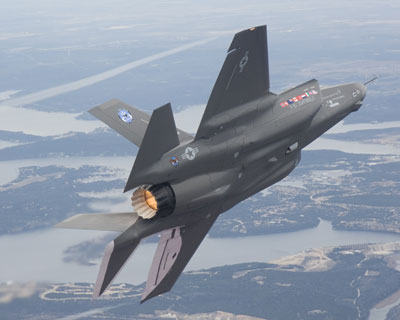
Lockheed Martin Corporation
Replacing the Canadian Manned Fighter Capability
by Lieutenant-General (ret’d) Lloyd Campbell
For more information on accessing this file, please visit our help page.
When I was Chief of Force Development (1996 – 1998), the Office of the Auditor-General convinced us of the need to develop Force Planning Scenarios to assist in developing Statements of Operational Requirement, Capability Based Planning, and so on. When we eventually did so, I cautioned the staff, as much as possible, to stick with scenarios based upon real events. The reason for this was not just a desire for authenticity, but also to ensure critics could not easily ‘kick the legs from under the stool’ by challenging the legitimacy of a particular scenario – and therefore, the associated operational requirements.
While the staff working this project expected it to be difficult, I think, the reality was that it was quite easy to find scenarios covering almost the full spectrum of operations. Short of an all-out conflict at theatre level, the 1990s were action-packed, and most elements of the Canadian Forces (CF) were committed to a variety of combat and near-combat missions. In the case of the fighter force, CF-18 Hornets were twice involved in conflicts – in the Gulf War of 1990 - 1991 by a Conservative Government; and again in the Kosovo Air Campaign of 1998, this time by a Liberal Government. Of course, since then, Canada and the world have also experienced ‘9-11,’ Afghanistan, and other significant international events.
The relevance of this little vignette is to remind Canadians how active our forces have been over the past 20 years, carrying out operations that were largely unpredicted. While such a reminder should not be required, it seems based upon at least some of the commentary regarding the F-35 Lightning II that it is human nature to forget quite quickly – hence the significant number of critics of the program who insist that Canada will never need the myriad capabilities represented by the F-35 over the course of the next four decades. Clearly, these individuals must be quite clairvoyant.
This article – which highlights why manned fighters remain important for Canada, and why the F-35, as programmed, is a prudent investment – is loosely based upon a 2010 article created by AFAC’s [then] Aviation Affairs Committee (AAC). This predecessor article was published in the Summer 2010 issue of Airforce magazine.1
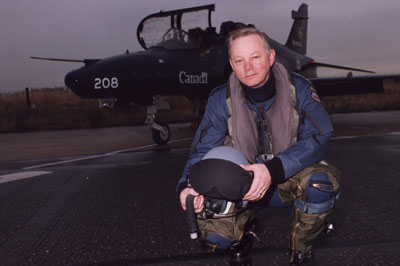
Author’s collection
You can take the boy out of jets, but you cannot take the jets out of the boy. Lieutenant-General Campbell gets familiar with a Canadian Forces CT-155 Hawk advanced jet trainer.
What are Fighter Operations?
Aerospace control is a primary operational function of all air forces. In peacetime, aerospace control capabilities are used to safeguard sovereignty. In times of tension, they are used to control access to specific airspace – for example, through the enforcement of ‘no fly zones,’ such as the one established over Bosnia in the late-1990s. In wartime, aerospace control capabilities are used to achieve air superiority, enable freedom of action in the aerospace environment – and on the surface for friendly forces – and to deny such freedom to one’s adversaries.2
In addition to aerospace control, force application is also a primary operational function for air forces. In combat operations, such as the Kosovo Air Campaign, attack missions are used to progressively destroy and disintegrate an adversary’s capacity or will to wage war.3
Historically, fighter aircraft have been used to provide aerospace control within Canadian airspace through partnership with the United States as part of the North American Aerospace Defence Command (NORAD). During the Cold War, Canadian fighters were also stationed in Europe as part of NATO’s deterrent against the Soviet Union and Warsaw Pact, where they carried out both aerospace control and force application missions for over 40 years.
The Current Force
Canada’s CF-18s have formed the backbone of the nation’s fighter force for nearly three decades, and they are currently one of the few means Canada has to project air power. In recent years, a significant investment has been made to upgrade our Hornets, including their various sensors and weapons, ensuring they will remain operationally relevant until the end of their estimated life expectancy (2017-2020). If the nation is to avoid a ‘strategic capability gap,’ it is critical that action be taken now to ensure a follow-on fighter is acquired early enough to achieve Initial Operational Capability (IOC) before our CF-18s retire.
Why Manned Fighters?
Fighter aircraft can provide significant firepower at a relatively low incremental cost of employment. They can be used to ensure freedom of action in the air, destruction of targets on the ground over vast geographic areas, and rapid support to ground forces in contact with enemy forces. The employment of Canadian fighters in support of Canadian troops is consistent with the stated CF intent to operate using integrated joint task forces and the objectives of most Canadians to ensure our ground and maritime forces, when engaged, are adequately protected.
In addition to projecting power, fighter aircraft provide an intelligence, reconnaissance, and surveillance (ISR) capability that is fundamentally important to the spectrum of missions cited in the Canada First Defence Strategy. Their inherent speed, agility, range, rapid response, and endurance, combined with ever-evolving communications and electronic sensors – enhanced by the critical ‘person-in-the-loop flexibility’ – allow fighter aircraft to perform demanding roles at home and abroad in support of Canada’s national interests and military forces.
There are some who have suggested that the current manned fighter capability provided by the CF-18 could be replaced at the end of the decade by an Unmanned Combat Aerial Vehicle (UCAV), or ‘combat drone.’ While great strides have been made with UCAVs (and UAVs in general), advanced platforms, such as the X-45 and the X-47, are still very much in their development phases. These aircraft are also being built to handle roles such as surveillance/reconnaissance, suppression of enemy air defences (SEAD) and strike (attacks on surface targets), rather than for aerospace control. Given these facts, it is inconceivable that an operationally viable, multi-role UCAV will become available in time to realistically replace the CF-18 fleet at the end of this decade.
It is also noteworthy that, for operations within controlled airspace – indeed, within any place where UAVs have to interact with commercial and private air traffic – they generally need to operate under special restrictions and to be equipped with sensors to ensure they can avoid collisions with other airspace users. While separating manned and unmanned traffic within airspace where Instrument Flight Regulations are imposed may prove possible in the near future, operations under more dynamic conditions – the type of conditions in which fighters are routinely expected to perform – will continue to be challenging for UCAVs and UAVs.
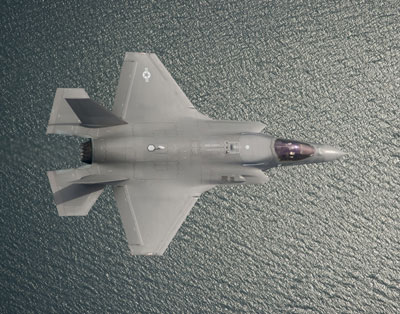
Lockheed Martin Corporation
F-35 Criticisms
While there has been a growing consensus that Canada needs a CF-18 replacement aircraft, there has been more vigorous debate with respect to the wisdom of the Government’s selection of the F-35 as its candidate aircraft. Some of this debate has been balanced, but much has been based upon misconceptions and half-truths, and some commentators – including those who should know better – have willingly contributed to the confusion that exists about the F-35. While this article will not attempt to ‘de-bunk’ all the ‘negatives,’ it will comment upon two of the most common criticisms.
Program Costs
It has frequently been noted that the F-35 is the “…largest defence procurement in Canada’s history.” The relevance of this statement is questionable, but so is its accuracy. The F-35 program is expected to cost $9 Billion – approximately $5.5 Billion for the 65 aircraft, and a further $3.5 Billion for contingency funding, program costs, integrated logistics support, weapons, infrastructure, simulation, and so on.4 The Canadian Patrol Frigate (CPF) program – while bought in two tranches – had a budget of $9.37 Billion in 1983–1998 ‘Buy Year Dollars,’ significantly more than $9 Billion in ‘2011 Dollars.’ It is also noteworthy that, when the CPF was purchased, projects were not required to account for as many of the equipment ‘extras,’ as is now the case.
It is also important to put the size of the F-35 program into context. $9 Billion dollars spread over 40 years (the likely duration of service for the aircraft) amounts to $225 Million dollars per year. If one adds $250 Million in annual maintenance costs – a bit unfair, actually, since most of these costs are being borne today to support the CF-18 – the annual expenditure increases to $475 Million. By way of comparison, the cost of running Ottawa’s transit service in 2010 was about $400 Million.
Finally, it is always important to recognize that the money designated for capital programs – in this case, the F-35 – comes from funds the government has already notionally committed to DND. So, if there is to be a debate, it should not be one concerning military expenditures versus some other national priority, but about which military programs should take precedence within the Department’s capital program. In this case, the Department and the Government have both clearly signaled that maintaining a fighter capability is a very high priority for capital spending, a position consistent with that of other Canadian Governments over many decades, and that the project is affordable as it is currently programmed.
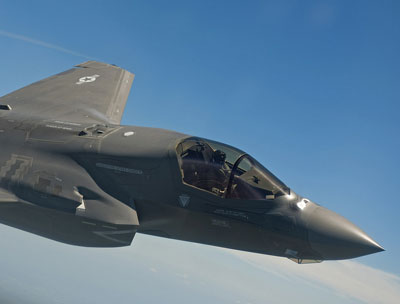
Lockheed Martin Corporation
The F-35 is not an ‘Air-to-Air’ Fighter
One of the most disturbing criticisms of the F-35 that has been proffered is that the aircraft is an ‘air-to-mud’ strike aircraft with little-or-no capability for air combat. While there is legitimate room for debate with respect to the merits of various platforms – fighter pilots will tell you this has always been the case – the reality is that the JSF/F-35 was designed from the outset, like the F-16s and the F-18s it replaces, as a multi-role combat aircraft, highly capable for both air-to-ground and air-to-air missions.
The F-35 has outstanding aerodynamic capabilities – including stealth to reduce acquisition ranges for adversary fighters as well as excellent manoeuvrability for close-in combat. But, its real strength is its integrated defensive and offensive sensor systems that provide the aircraft with the ability to see, identify, and counter everything around it, day or night. It is in this area, avionics, where proponents of the aircraft – including a large number of fighter pilots – suggest that technology will provide the aircraft with a distinct advantage over lesser aircraft, including those currently classed as 4th or ‘4th-and-a-half’ generation.
A key feature of the F-35 is Northrop Grumman’s Defensive Aperture System (DAS), a 360-degree, spherical situational awareness system capable of providing F-35 pilots information on incoming aircraft and missiles, 360-degree day and night vision, fire control capability, and precision tracking of wingmen/friendly aircraft for tactical maneuvering. Images gathered by the aircraft’s sensors are fused to create a seamless ‘bubble’ of situational awareness surrounding the aircraft. Because the system is passive, the pilot does not have to ‘point’ the sensor to gain a track solution on an adversary.5
F-35 Strengths
In addressing the criticisms that have been leveled against the F-35, this article has, in the process, already addressed a number of the aircraft’s positive features as well. However, the one main attribute that puts the F-35 into a different category than its potential Western competitors for the Next Generation Fighter Capability (NGFC) project is the fact that it is at the very commencement of its technological life; if one looks at the other aircraft that might have competed for the project, all were developed in the 1990s or earlier. Buying one of these aircraft in the 2020 timeframe would have been a bit like buying a brand-new 2000 BMW in the same year: the car would be shiny, but the technology would be passé, and it would not be the kind of car one would be looking to have parked in the garage come 2050 or so. It is as simple as that…
Conclusion
There are always issues associated with military purchases in democratic nations, and Canada, of course, is no exception. Today, we look at the CF-18 as having provided outstanding capabilities and excellent value to Canada over its almost 30 years of service to date. But, if we step back to the early-1980s, we should remind ourselves that after its selection, the CF-18 was subject to huge criticism within the press and elsewhere: it had insufficient range; it was a carrier aircraft, and Canada did not possess aircraft carriers; its costs were escalating; and so on. In the end, as we know, the CF-18 has turned out to be a fabulous aircraft and a great addition to Canada’s combat capabilities. With its recent upgrades, Canadians can be confident it will continue to serve the nation well until the end of its service life.
In 2011, the F-35 is in a very similar position to where the F-18 was in the early 1980s. The F-18 was a relatively large expenditure. Indeed, in relative terms, it was larger than the F-35, although more aircraft were acquired. It represented new technology that had not been proven in any other service. And it was in competition with a number of other very capable aircraft. Based upon its historical performance, the CF-18 went on to prove to Canadians that it was clearly the right choice. Assuming the F-35’s development, testing, and pricing remain broadly ‘on track,’ I believe that when Canadians look back in 30 or 40 years, they will be equally convinced our nation once again made the right choice.
Per Ardua Ad Astra
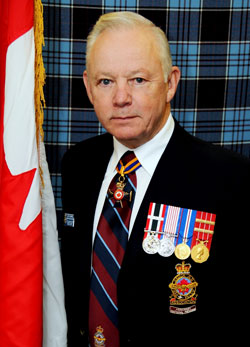
Author’s collection
Lieutenant-General (ret’d) Lloyd Campbell as the Honorary National President of the Air Force Association of Canada.
![]()
Lieutenant-General (ret’d) Lloyd Campbell, CMM, CD, a highly experienced fighter pilot, has commanded at all levels in the Canadian Air Force, including Commander Air Command and Chief of the Air Staff (CAS). He is currently Honorary National President of the Air Force Association of Canada (AFAC).
Notes
- Airforce, Vol. 34, No. 2, Summer 2010, pp. 30-31.
- The Aerospace Capability Framework (ISBN # 0-662-35613-6), 2003, p. 9.
- Ibid., p. 10.
- André Deschamps, “Meet the F-35 Lightning II,” in Canadian Military Journal, Vol. 11, No. 1, pp. 49-52.
- For further on DAS, see this Northrop Grumman video for useful insights into DAS and what it means to the F-35’s air-to-air capabilities: <http://www.es.northropgrumman.com/solutions/f35targeting/assets/eodasvideo.html>.






